News
Drought worsens lives of 117,000 people across island
View(s):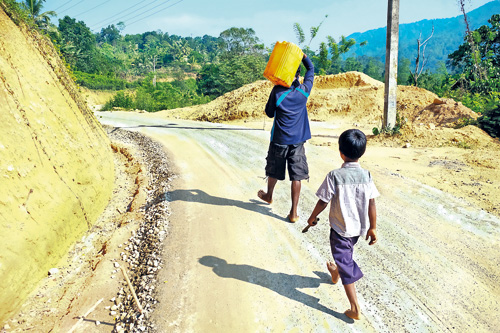
Bambarawadola, Neluwa: In search of water Pix by Ishanka Sunimal and Amila Gamage
More than 117,000 people from 33,775 Sri Lankan families across the island are once again facing the double whammy of debilitating drought and the lack of water for drinking, livestock, and cultivation as of this month.
The numbers of people suffering from the drought has been rising since January.
Many small tanks and reservoirs have dried up despite the reasonable rains during the monsoon, according to the Department of Meteorology.
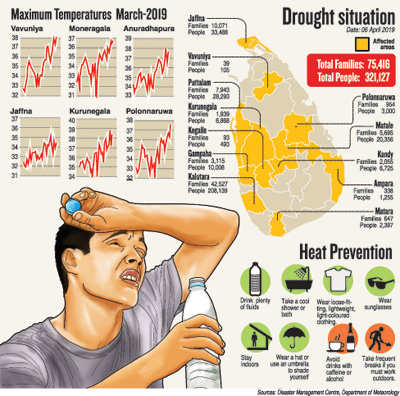
The worst drought hit regions are Puttalam, Vavuniya, Jaffna, Gampaha, Matara, Polonnaruwa and Kandy.
According to the Disaster Management Center (DMC), some 117,378 people from 33,775 families are suffering.
The Ministry of Disaster Management, via its arm the DMC, has allocated Rs 6.65 million for the affected families. Meanwhile, 300 water tankers and 4,471 water tanks have been distributed across 13 districts, so far.
This came in the wake of a renewed heat index advisory issued by the Department of Meteorology this week forecasting severe heat until April 15.
In Puttalam, 8 of 16 divisions are suffering without water.
Dankotuwa, Aarachchikattuwa, Mundalama, Pallama, Mahawewa, Naththandiya and Nawagathhena divisions have 8,000 — the highest number — affected.
The District Secretary N H M Chitrananda said water collection points have been set up. “We have not begun issuing dry rations, but we are monitoring the conditions.” Mr Chitrananda added the heat wave arrived unusually early.
Puttalam’s coconut yields have also declined. According to the District Secretary, many plantation owners have complained that the heat was to blame.
The Jaffna District Secretary, N Vedanayahan, told the Sunday Times that usually the drought is experienced by the end of April following the Sinhala and Tamil new year festivities.
Neduntivu, Kayts, Delft, Maruthankerni and Karainagar are provided with drinking water points for the people.
“We have taken adequate steps to provide drinking water to the northern islands where it has become a major issue during the drought,” he said. At least 50 non-irrigation category tanks were renovated by the District Secretariat to store rain water for livestock, and farming.
According to Mr Vedanayahan, the department has taken steps to implement an ambitious water project called ‘Aarumugam Plan’ to use rain water stored in the Vadamarachchi lagoon.
Dr Shiromani Jayawardena, the deputy director for Research and Climate Change at the Department of Meteorology, predicts higher temperatures by 2050. She has been studying the weather patterns of Sri Lanka over the years.
“There is no predominant wind now, but a very calm one. The high humidity makes people uncomfortable and they continuously sweat,” said Dr Jayawardena explaining why many feel that their body temperature is higher compared with the environment.
According to Dr Jayawardena’s study of Sri Lanka’s weather patterns over the years, two weather scenarios emerged based on emissions of greenhouse gas. In a moderate emissions scenario, the maximum temperature will increase from 1 to 1.6 degrees Celsius, whereas with high emissions, it would rise from 1.6-2.5 degrees by 2050.
Usually, by the third week of March, thundershowers were likely but it was not to be.
The National Water Supply and Drainage Board issued a notice this week urging the public to use water wisely.
A joint bulletin by the World Food Programme and Ministry of Public Administration and Disaster Management, titled “Climate and Food Security Monitoring,’’ shows that the current reservoir water level is 65%, and that more water is needed for a successful Yala season.
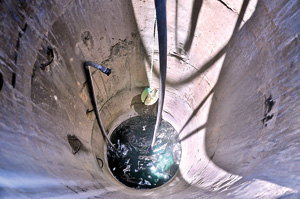 Verugal: Water levels in wells are rapidly receding | 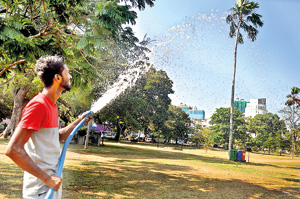 A refreshing, rejuvenating spray |
Heat-related risks rise
The Department of Meteorology has issued a severe heat index advisory for the Northwestern Province and the districts of Mannar, Vavuniya, Mullaitivu, Hambantota and Monaragala, warning that the human body temperature may spike up to 42 centigrade as the sun will be moving directly overhead Sri Lanka until April 15.
The heat is expected to increase from 32-41 centigrade and people are being advised to watch out for heat cramps and heat exhaustion. There is also the risk of heat stroke.
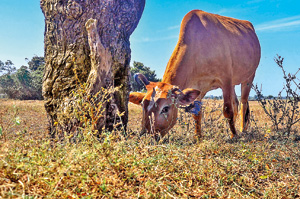
Ichchilampattu: Even animals are affected
Meanwhile, the Ministry of Health, Nutrition and Indigenous Medicine, advised those working outdoors to stay hydrated and take breaks in the shade whenever possible.
The elderly and children may suffer bouts of heat exhaustion and should limit strenuous outdoor activities.

